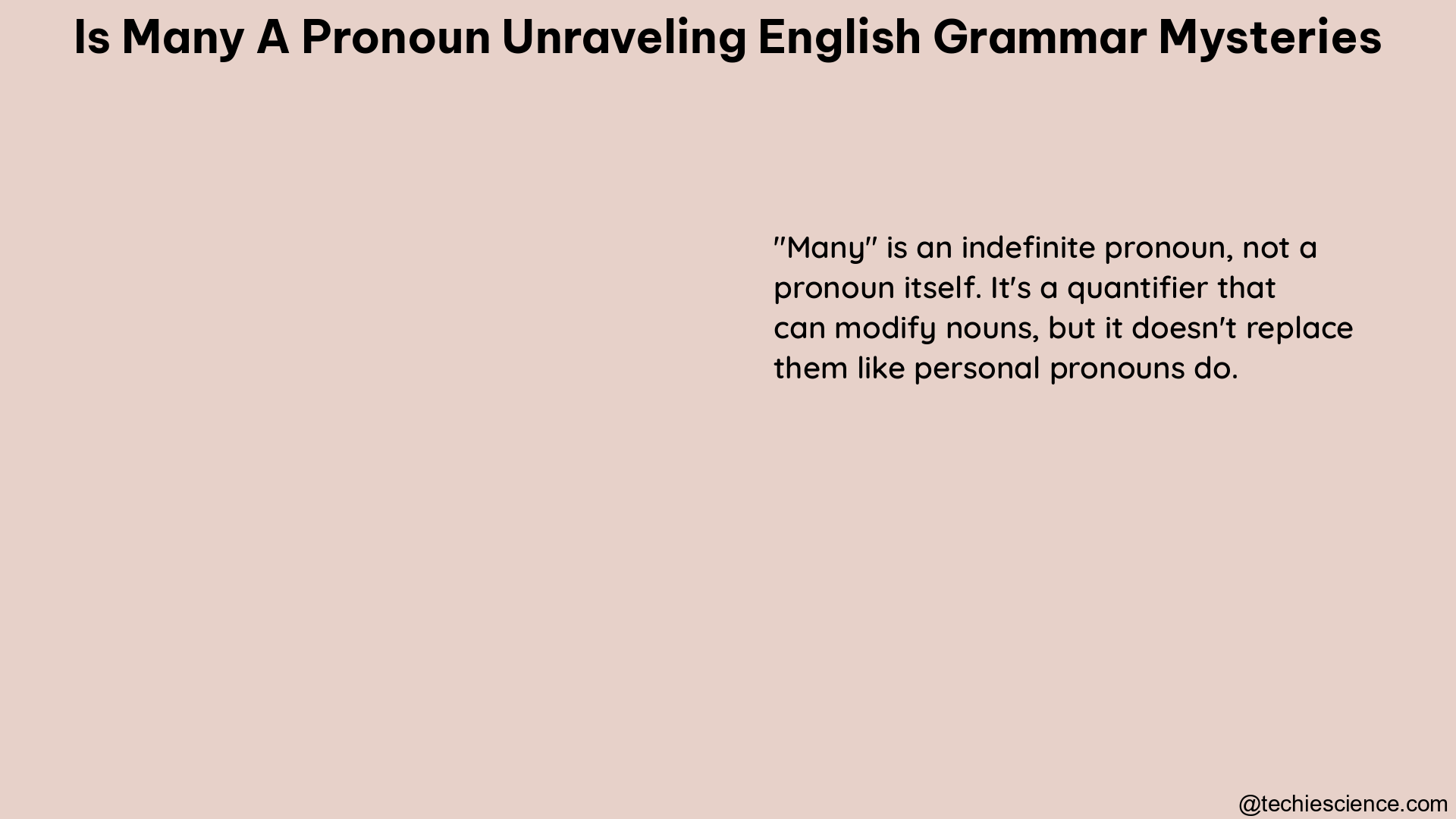The question “Is ‘many’ a pronoun?” is a crucial aspect of unraveling English grammar mysteries. To clarify this, let’s delve into the details of pronouns and their functions in English grammar.
What are Pronouns?
Pronouns are words that replace nouns in a sentence to provide clarity and avoid repetition. They can refer to people, places, things, or ideas. Examples of common pronouns include “he,” “she,” “it,” “they,” and “many” itself.
Is ‘Many’ a Pronoun?

Yes, “many” is a pronoun. It is a determiner pronoun, which is used to indicate the quantity or amount of something. Determiner pronouns include words like “all,” “both,” “each,” “few,” “many,” “much,” “neither,” “some,” and “several.” These pronouns are used to specify the quantity or extent of a noun or noun phrase.
Examples of ‘Many’ as a Pronoun
- “Many people attended the concert.” (Here, “many” is used to indicate the quantity of people.)
- “I have many friends.” (Here, “many” is used to indicate the quantity of friends.)
Advanced Details and Theoretical Explanation
In English grammar, pronouns can be classified into several categories, including personal pronouns, possessive pronouns, reflexive pronouns, demonstrative pronouns, interrogative pronouns, and determiner pronouns. Determiner pronouns, like “many,” are used to express the quantity or extent of a noun or noun phrase. They are often used in combination with other determiners like articles (the, a, an) and other quantifiers (some, any, all).
Grammatical Specification
Determiner Pronouns
These pronouns are used to specify the quantity or extent of a noun or noun phrase. Examples include “all,” “both,” “each,” “few,” “many,” “much,” “neither,” “some,” and “several.”
Quantifiers
These are words that express the quantity or extent of a noun or noun phrase. Examples include “some,” “any,” “all,” “both,” and “each.”
Theoretical Explanation
Determiner pronouns, such as “many,” are a subclass of pronouns that function as determiners in a noun phrase. They provide information about the quantity or amount of the noun they modify. Unlike personal pronouns, which replace the noun entirely, determiner pronouns work in conjunction with the noun to specify its quantity or extent.
The use of “many” as a determiner pronoun is particularly interesting because it can be used both as a pronoun and as an adjective. When used as a pronoun, “many” stands alone and refers to a specific quantity, as in the examples provided earlier. When used as an adjective, “many” modifies a noun, as in “Many people attended the concert.”
It’s important to note that the distinction between determiner pronouns and quantifiers can sometimes be blurred, as they often overlap in their functions. However, the key difference is that determiner pronouns are used to specify the quantity or extent of a noun phrase, while quantifiers are used to express the quantity or extent more broadly.
Practical Applications and Exercises
To solidify your understanding of “many” as a pronoun, try the following exercises:
- Identify the use of “many” in the following sentences:
- “Many of the students passed the exam.”
- “I have many books on my shelf.”
-
“How many apples do you want?”
-
Rewrite the following sentences, replacing the noun with a pronoun:
- “The students attended the concert in large numbers.”
- “The books on the shelf are quite interesting.”
-
“The apples in the basket are ripe.”
-
Explain the difference between the use of “many” as a pronoun and as an adjective in the following sentences:
- “Many people attended the concert.”
- “The concert was attended by many people.”
By practicing these exercises, you’ll deepen your understanding of “many” as a pronoun and its role in unraveling the mysteries of English grammar.
Conclusion
In conclusion, “many” is indeed a pronoun, specifically a determiner pronoun, used to indicate the quantity or amount of something. Understanding the different types of pronouns and their functions is essential to unraveling the mysteries of English grammar.
References:
- https://iasce.net/decoding-grammar-pronoun-english/
- https://www.wordstrivia.com/grammar/grammar-mysteries-7-rules-youve-probably-never-heard-of
- https://iasce.net/possessive-relative-pronoun-english-grammar/

The lambdageeks.com Core SME Team is a group of experienced subject matter experts from diverse scientific and technical fields including Physics, Chemistry, Technology,Electronics & Electrical Engineering, Automotive, Mechanical Engineering. Our team collaborates to create high-quality, well-researched articles on a wide range of science and technology topics for the lambdageeks.com website.
All Our Senior SME are having more than 7 Years of experience in the respective fields . They are either Working Industry Professionals or assocaited With different Universities. Refer Our Authors Page to get to know About our Core SMEs.